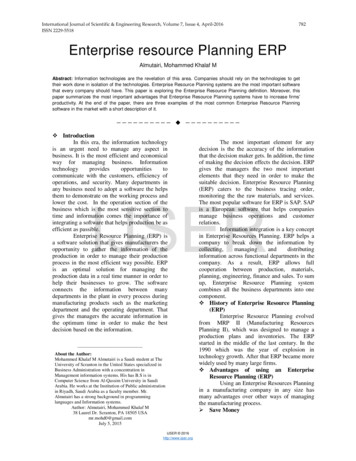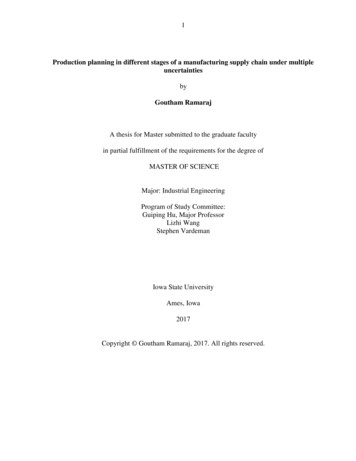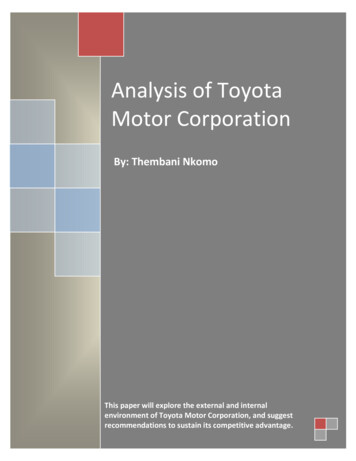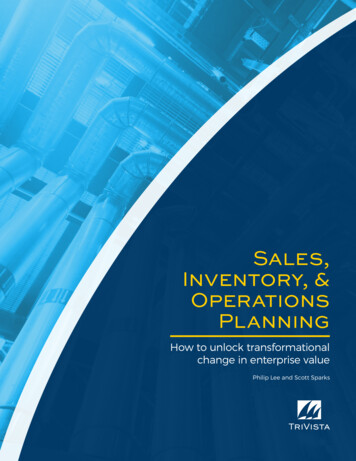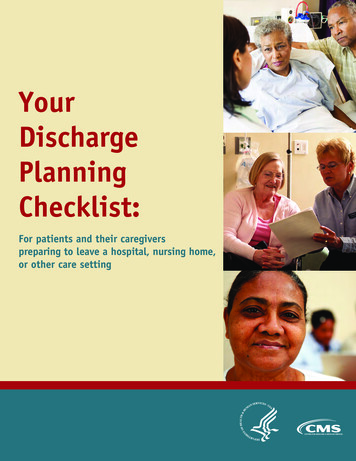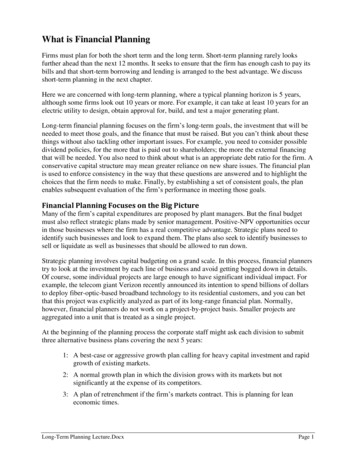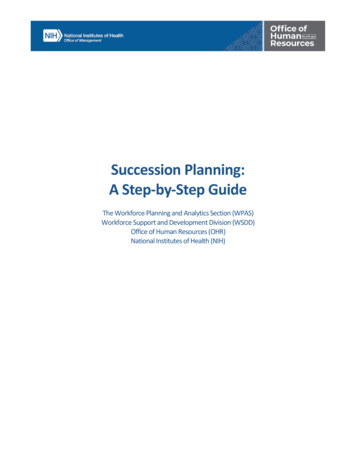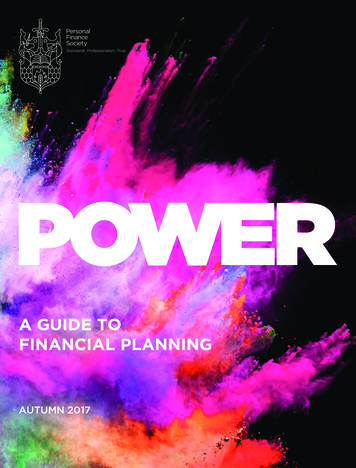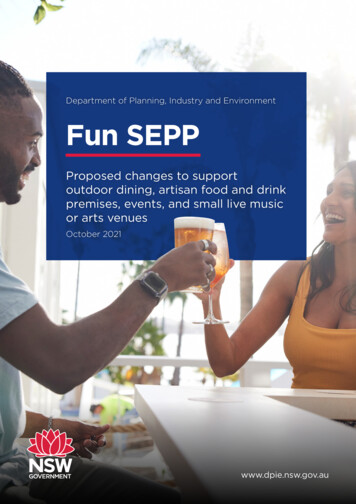
Transcription
Department of Planning, Industry and EnvironmentFun SEPPProposed changes to supportoutdoor dining, artisan food and drinkpremises, events, and small live musicor arts venuesOctober 2021www.dpie.nsw.gov.au
Acknowledgement of CountryThe Department of Planning, Industry and Environment acknowledgesthe Traditional Owners and Custodians of the land on which we liveand work and pays respect to Elders past, present and future.Find out more:www.dpie.nsw.gov.auTitle: Outdoor dining & fun experiencesFirst published: October 2021Cover image: Destination NSW State of New South Wales through Department of Planning, Industry and Environment 2021. Youmay copy, distribute, display, download and otherwise freely deal with this publication for any purpose,provided that you attribute the Department of Planning, Industry and Environment as the owner.However, you must obtain permission if you wish to charge others for access to the publication (otherthan at cost); include the publication in advertising or a product for sale; modify the publication; orrepublish the publication on a website. You may freely link to the publication on a departmental website.Disclaimer:The information contained in this publication is based on knowledge and understanding at the time ofwriting (October 2021) and may not be accurate, current or complete. The State of New South Wales(including the NSW Department of Planning, Industry and Environment), the author and the publishertake no responsibility, and will accept no liability, for the accuracy, currency, reliability or correctnessof any information included in the document (including material provided by third parties). Readersshould make their own inquiries and rely on their own advice when making decisions related to materialcontained in this publication.Department of Planning, Industry and Environment Outdoor dining & fun experiences2
ContentsMinister’s Foreword 5About this explanation of intended effect 6Proposals 6What is exempt and complying development? Outdoor dining 67Overview 7Small live music or arts venues 9Overview 9Providing flexibility for the arts industry and neighbourhoods 10Proposed amendments 10Artisan food and drink industry 13Overview 13Proposed amendment Making some temporary COVID-19 measures permanent 1415Overview 15Temporary events 16Overview 16Proposed amendments 17Filming 21Overview 21Have your say 23How to make a submission Department of Planning, Industry and Environment Outdoor dining & fun experiences233
Photography:Jay Black/DPIEDepartment of Planning, Industry and Environment Outdoor dining & fun experiences4
Minister’s ForewordSummer is on its way and we want to make upfor lost time. We’ve been stuck indoors, unableto do the simple things we enjoy with our friendsand family.We want to make it simpler, faster and cheaperfor businesses to get back on their feet. Wewant to help the arts and hospitality industries,which have been some of the hardest hit by thepandemic, get back to giving us the fun and joyof music, dance, arts, and showcasing the besttalent, food and drink our state has to offer.Life won’t look the same as before – it won’t bebusiness as usual. Many venues won’t be able towelcome us all back straight away. This gives usa chance to adapt and experiment – with later,longer, smaller events popping up in more andnew locations. We want to adjust the settings socreatives and councils can make the most of howthis might look in their local area, and bring backthe connections and creativity we’ve missed inour streets and towns.We have a fantastic climate, and spectacularplaces and open spaces around the state.So when lockdown eases, let’s move indoorsoutdoors, raise a glass and get back out there.The Hon. Rob Stokes, MPMinister for Planning and Public Spacesand Minister for Transport and RoadsPhotography:Destination NSWDepartment of Planning, Industry and Environment Outdoor dining & fun experiences5
About this explanation of intended effectTo support hospitality, events and arts industriesuse exempt and complying development, theNSW Department of Planning, Industry andEnvironment proposes reforms to a governmentpolicy called the State Environmental PlanningPolicy (Exempt and Complying DevelopmentCodes) 2008 or the Codes SEPP.The department has prepared this explanationof intended effect (EIE), which sets out theaims of the reforms, under section 3.30 of theEnvironmental Planning and Assessment Act 1979(EP&A Act).ProposalsWe would like to inform you of the followingchanges to the State Environmental PlanningPolicy (Exempt and Complying DevelopmentCodes) 2008 (Codes SEPP): make permanent the trial that allow pubs andsmall bars to have outdoor dining on thefootpath as exempt developmentand seek feedback on proposals to: create a complying development pathway toallow a change of use of retail premises tosmall live music or arts venues, includingdevelopments standards and variations to theBuilding Code of Australia create a complying development pathwayto allow a change of use of premises toartisan food and drink industry in certaincircumstances, including developmentstandards make some of the COVID-19 emergencymeasures for food trucks and dark kitchenspermanent. clarify the exempt development standards fortemporary private and community events extend the number of days for filming asexempt developmentThe proposed changes will help to deliver a24-hour economy that is vibrant, diverse, inclusiveand safe. They will help the hospitality and artsindustries to recover from the pandemic byproviding flexibility and a simpler, faster planningprocess. It will make it easier to hold outdoor events,film, set up artisan food and drink premises orconvert shops to arts or live music venues.What is exempt andcomplying development?The Codes SEPP contains the exempt andcomplying development standards that applystatewide.Exempt development is minor and low-impactdevelopment that can be carried out withoutthe need for approval, as long as it meetspredetermined criteria.Complying development is a fast-trackedapproval process for straight-forwarddevelopment where planning and buildingstandards can be signed-off by an accreditedcertifier. This process offers many benefits toapplicants including certainty, as well as timeand cost savings compared with a developmentapplication (DA). Complying developmentcertificates (CDC) can be issued by council orprivate accredited certifiers within 10 days.Complying development must strictly complywith the development standards in the CodesSEPP. If a development cannot comply withjust one of these controls, it cannot obtain aCDC and must go through the DA pathway. Thedevelopment controls are designed to manageamenity and ensures the development will notsignificantly affect surrounding properties.Department of Planning, Industry and Environment Outdoor dining & fun experiences6
Outdoor diningOverviewWe’re making outdoor dining on the footpathfor pubs and small bars exempt development.Outdoor dining and entertainment is a year-roundopportunity for NSW; we have the perfect climateto socialise outdoors, day and night. It bringsactivity to our streets and public spaces, attractingresidents and tourists alike to showcase the best ofour local produce, hospitality and talent.In October 2020, the department helped pubsand small bars to quickly provide outdoordining areas as COVID-19 safety measureslimited the number of people allowed insidevenues. We’ve trialled a streamlined processwhere councils approve outdoor dining withoutneeding business owners to submit a separatedevelopment application. This is a more efficientprocess for councils and saves time and moneyfor the hospitality industry, which has struggledthrough the COVID-19 pandemic. It helps to keepbusinesses open and staff employed, and gives usmore safe spaces to dine and socialise.During the trial, we have supported councils andbusinesses to expand outdoor dining areas – makingthe most of temporary road closures, local eventsand coordinated activations for the public to enjoy.Trial of fast-track outdoor diningapprovalsThe outdoor dining trial for pubs and small barsruns from 16 October 2020 until 31 October 2021.During this time, councils and Place ManagementNSW (the managers of The Rocks and DarlingHarbour) have approved outdoor dining areas atsmall bars and pubs as exempt development.Councils have used their own outdoor diningpolicies and approved outdoor dining onfootpaths and roads under the Roads Act 1993(Roads Act) and Local Government Act 1993(Local Government Act). Approvals are thenfast-tracked to Liquor & Gaming NSW to approvenew liquor licence boundaries in as little as 3 daysunder the Liquor Act 2007 (Liquor Act).Photography:Anna Kucera/DPIEDepartment of Planning, Industry and Environment Outdoor dining & fun experiences7
Making the trial permanentThe trial has run smoothly. Businesses havebenefited from increased turnover and thecommunity has enjoyed new outdoor diningareas. We will be making this change permanentbefore the trial measures expire to ensure pubs,small bars, cafés and restaurants are ready tooffer outdoor dining when lockdown eases, and toattract people back to outdoor dining as soon asit is safe to do so.The Rocks Outdoor Dining TrialCommencing in October 2020, The Rocksoutdoor dining trial provided immediatesupport for local businesses recovering fromCOVID-19.There were 24 businesses in the trial.Footpaths, road areas and parking bays wereexpanded into over 2,000 square metres ofadditional outdoor dining space. This cateredfor over 1,000 extra diners at any given time –in line with COVID safety restrictions.In the first quarter, gross revenue on foodand beverage for businesses in The Rocksincreased by 101% when compared to theprevious quarter, before the trial. Mostbusinesses in the area now attribute theirongoing financial recovery to the expansionof outdoor space to serve customers.OutcomesRemoving duplication in the approvals process,which save time and money for businesses, andassisting the industry to continue to operate ina COVID-19 safe manner.Photography (top and bottom):Anna Kucera/DPIEDepartment of Planning, Industry and Environment Outdoor dining & fun experiences8
Small live music or arts venuesOverviewWe’ve missed the thrill of live music, performanceand arts, whether it’s as part of the audience oras a creative outlet for our hobbies and passions.For a sector that has been one of the hardest hitduring the pandemic, we’d like to help make surethat the show can go on.The independent arts sector has previously raisedthe lack of affordable and suitable small- tomedium-sized performance spaces as a criticalissue. There are barriers preventing shops andcommercial spaces from being used as small-scalevenues in NSW.Arts and performance venues are classed inthe Building Code of Australia (BCA) as ‘publicassembly buildings’, such as a night club orsporting facility. These have higher fire and buildingstandards than shops to ensure public safety. Asa result, the cost and time to gain approval andupgrade a small venue to the higher building classstandards means converting retail premises is oftennot financially viable for the arts sector.In November 2020, new legislation introduced theterm small live music or arts venue into the BCANSW. This also established some developmentstandards to limit the size and patron capacity ofvenues to reduce risk and remove the need for thehigher building classification.At the time, these changes did not establish acomplying development pathway to change theuse of a shop or food and drink premises to asmall live music or arts venue without needing adevelopment application.To address this, we are proposing 2 changes: to amend the BCA so that a small live musicor arts venue is treated as a Class 6 buildingin NSW to introduce a new complying developmentpathway with accompanying building, firesafety and amenity development standards.The changes have been developed withaccredited fire and building certifiers and theDepartment of Customer Services’ Building PolicyUnit to ensure that public safety is maintained.South Australia and Victoria have already madeequivalent changes to the BCA in their states.Photography:Destination NSWDepartment of Planning, Industry and Environment Outdoor dining & fun experiences9
Providing flexibility forthe arts industry andneighbourhoodsSupporting the conversion of shops into newfunctions is important as online shopping andeconomic conditions changes the nature oftraditional retail. Centres and high streets willcontinue to reinvent themselves to attract newbusinesses and uses.A complying development pathway will significantlyreduce start-up costs and lead times for small livemusic or arts venues to establish and operate.This will allow local arts groups and creativeindustries to be flexible and agile and take upopportunities presented by changing retailconditions.Proposed amendmentsWe propose to make amendments so small livemusic and arts venues: are in the same building class as shops, cafésand restaurants through a state variation tothe Building Code of Australia classification can use the complying development changeof use and development standards in theCodes SEPP.Changes to the Building Code ofAustralia and Codes SEPPThe department will amend the Building Code ofAustralia in NSW to allow suitable ‘shops’ or ‘foodand drink premises’ to change use to a small livemusic or arts venue. This means creative industriescan apply for a Complying DevelopmentCertificate from a registered or council certifierto ensure their venues are safe and meet thestandards without needing a developmentapplication.Photography:Destination NSWDepartment of Planning, Industry and Environment Outdoor dining & fun experiences10
We are proposing that for premises to be used asa small live music or arts venue, they must meetthe following criteria: have a maximum floor area of 300 metres2 not be located above the second storey of abuilding not occupy more than 2 storeys in a building,including the ground floor provide cultural activities to the public such aslive music, visual arts displays, dancing, poetryand spoken word performances display fire safety approvals such as acurrent fire safety certificate and emergencyevacuation diagram not use pyrotechnics or theatrical smoke(smoke machines, hazers or the like) or havetiered or fixed seating have a maximum occupancy limit of 300people (including staff and performers) or50 people if food and drink are provided provide sanitary facilities based on employeeand patron numbers in F2.3 and Table F2.3 ofthe BCA for a Class 6 pub, restaurant, café,bar or equivalent may operate from 7.00 am to 10.00 pmMonday to Saturday and 7.00 am to 8.00 pmon a Sunday or a public holiday.These measures manage the risk of fire orhazardous situations and limit patron capacityto be consistent (for health, safety and amenity)with the Class 6 BCA category and standards.The NSW definition of Class 6 buildings will allowmultiple venues in one building.Venues can be used for a range of arts, handicraftand performance activities; however, this excludesbuilding or production activities, such as woodor metal cutting, that require fixed machinery.More intensive activities which include productionelements and machinery that pose a potentialhigher risk will be categorised under a new term‘creative industries’ which was proposed in theEmployment Zones Reform exhibition.Photography:Destination NSWWhat do you think?Are the proposed development standards forbuilding, fire safety and amenities appropriatefor this use?OutcomesTo support the arts industry to captialise onopportunities to use small retail spaces forperforming and carrying out activities in away that saves time and is cost effective.Department of Planning, Industry and Environment Outdoor dining & fun experiences11
Photography:Destination NSWDepartment of Planning, Industry and Environment Outdoor dining & fun experiences12
Artisan food and drink industryOverviewThe artisan food and drink industry includes themaking or manufacturing of boutique, artisanor craft food or drink products, such as bread,cheese, cured meat, coffee and alcohol. They aremade locally, on a small scale, using traditionalmethods or recipes. The small-batch goods arepopular alternatives to mass-manufactured andimported products. The industry generates localskilled employment and can support associatedindustries such as agriculture, tourism andhospitality by attracting customers who want tosample the products and see how they are made.A new definition of the artisan food and drinkindustry was introduced into the StandardInstrument LEP in 2018, which reflects the new typeof mixed-use business where the main purposeis manufacturing a product with a smaller spacefor product sales, tastings, a restaurant or café.Previously, they had been considered a light industryand required additional approvals for an industrialretail outlet to sell the products made on site.Allowing a change of use ofpremisesThe artisan food and drink industry is a type oflight industrial use and is permissible whereverlight industry is in an environmental planninginstrument, such as an LEP. This typically includesindustrial and business zones, and less frequentlyin rural zones.There is currently no exempt or complyingdevelopment pathway for a change of use to anartisan food and drink premises in the Codes SEPP.We have heard that some producers would like toconvert their light industry development consentsto artisan food and drink without needing tosubmit a new development application to assessthe ongoing operations. We have also heard thatthe restriction on industrial retail outlets thatonly allow for the sale of products made on siteis impractical and overly restrictive. An examplecould be a coffee roaster who may also wish tosell reusable cups manufactured off site.We propose this amendment within the broadercontext of work the department is doing to driveeconomic recovery and support innovation andproductivity: Building Business Back Better Employment Zones Reforms AgritourismPhotography:Destination NSWDepartment of Planning, Industry and Environment Outdoor dining & fun experiences13
Proposed amendmentChange of use to artisan food anddrink as complying developmentWe are proposing a complying developmentpathway that would allow a change of use fromlight industry or a light industry with an industrialretail outlet to an artisan food and drink industry.These uses are permissible with consent in theEnterprise Corridor (B6) and Business Park (B7),General Industrial (IN1), Light Industrial (IN2)and Working Waterfront (IN4) zones and artisanfood and drink is consistent with their objectives.We would also like to include the BusinessDevelopment (B5) zone, which the EmploymentZone Reform propose to incorporate into a newE3 Productivity Support zone with B6 and 7.Proposed changesWe’re also proposing changes to artisan food anddrink industries that reflect those consulted on inthe Building Business Back Better reforms. Theseproposed to increase patron numbers from 50 to100 in food and drink premises in neighbourhoodand local centres (that is, B1 and B2 zones) andincreased hours of operation. We would like tohear your views on extending these provisions tothe artisan food and drink industry.The production function will remain the mainpurpose at the site. The development standardswould see: a maximum retail floor area 30% of grossfloor area, or 500 m2, or any limit in the LEP,whichever is lesser maximum of 100 patrons at any restaurantor café trading hours for food and drink premises andretail sales from 6 am to 10 pm while allowing24-hour operations (for baking, brewing,fermenting and so on). This does not over-rideother laws, for example liquor licence conditions premises must comply with AustralianStandard 4674-2004 Design, construction andfit-out of food premises and the requirementscontained in the Noise Policy for Industry 2017.Photography:Destination NSWWhat do you think?Do you think the proposed changes strike theright balance for the uses in these locations?OutcomesIntroducing a swift and simple change of usepathway for artisan food and drink businessesso they can easily increase their operations,while aligning with standards.Department of Planning, Industry and Environment Outdoor dining & fun experiences14
Making some temporaryCOVID-19 measures permanentOverviewLast year, we made a number of temporary measuresto support the community and businesses inresponse to the COVID-19 pandemic. While they wereintended as a temporary solution, we would like tomaintain those that have been beneficial to thecommunity. We would also like to support businessesto be flexible and adapt to changing situations aslockdown requirements change over time.Food trucksFood trucks were introduced as exemptdevelopment in 2013, and the temporary measuregave businesses more flexibility by allowing foodtrucks to operate on any land, at any time, subjectto land owners’ consent. We propose to maintainthe existing measure and provide some additionalflexibility on land adjoining a residential zone, byincreasing the hours a food truck can operate there.‘Dark kitchens’ — takeaway anddeliveries from existing food anddrink premises and commercialkitchensAs cafés and restaurants were forced to close,takeaway and home delivery became vital forthese businesses to survive. These services werea welcome treat for the community and helpedpeople maintain a sense of normality. Even beforethe pandemic, home delivery was growing inpopularity and there were more delivery optionsto choose from.Dark kitchens cook meals solely for delivery,rather than eat-in diners. We propose to continueto allow premises with an existing commercialkitchen, including restaurants and cafés,community facilities, cooking schools and functioncentres, to prepare, sell and deliver food anddrinks that can be consumed off site. This willenable existing restaurants and cafés, and otherbusinesses, to adapt when necessary to changingsituations and customer needs.OutcomesEncourage local food businesses tocontinue to operate and service their localcommunities.Photography:Destination NSWDepartment of Planning, Industry and Environment Outdoor dining & fun experiences15
Temporary eventsOverviewCultural celebrations, exhibitions, fetes, markets,music and sporting events help make ourneighbourhoods vibrant places to live, workand visit. They allow us to get outside, connectcommunities, celebrate and participate. They givea platform for a thriving performance and musicscene, let us share each other’s food and culture,and support local organisations and business.We want to make sure events are well managed,that the rules are easy to understand andappropriate to the scale of the event.We want to clarify that events on council-ownedor managed land don’t need separate planningapproval. Councils can use their event applicationprocess to assess proposals against their eventpolicies and any management plans that applyto the site. They will approve the event underlegislation such as the Local Government Act 1993.Events on private land, however, are not subjectto the same approvals and oversight of council.We’d like your help to determine sensible controlsto make sure private events are equally wellmanaged without disturbing the environment orneighbours’ amenity.Providing certainty for councilsand the communityThe Codes SEPP includes separate planningcontrols for community and private events. We’veheard that the structure and wording for temporaryevents are not clear and cause confusion.Users are interpreting the controls differently,either:1. using the land for a temporary event requiresa development application and must abideby the development standards in clause 2.8of council’s local environmental plans (LEP),while the temporary structures used for theevent (such as a stage) can be set up asexempt development under the Codes SEPPor2. both the use of the land for the temporaryevent and the event’s temporary structures areexempt development under the Codes SEPP.Some councils have also included exemptdevelopment standards for temporary eventsin Schedule 2 of their LEP, which may intend toprovide additional flexibility or clarity.A temporary eventcould be a fair, fete,market sporting orcultural event or thelike that is open tothe public or sectionof the public thatis held for a limitedamount of days peryear. For example afood market that isheld every month.Photography:Destination NSWDepartment of Planning, Industry and Environment Outdoor dining & fun experiences16
Proposed amendmentsTemporary events on council andprivate landWe are aiming to provide clear and easy-to-useplanning controls so that people know whatapprovals, if any, they need for their event. Wewant to support small and low-impact events witha simple and straightforward process, and makesure the success of larger events isn’t at the costof the environment or local amenity.We have split the provisions into events on councilland and private land. Whether an event is held onpublic or private land, the general requirementsfor temporary uses and structures will also apply.These are standard considerations, such ashaving the landowner’s permission and ensuringstructures are safely installed.Council-owned and managed landWe are proposing that temporary events oncouncil-owned and managed land would notneed separate planning approval. Events onpublic/community land require council’s approvalunder section 68 of the Local Government Act1993, which can consider amenity, safety andpotential environmental impacts. Other approvalsmay also be needed from council if a street closureis needed, or from other agencies to ensure foodsafety and responsible service of alcohol.Councils also have plans of management for theland that they own or manage and typically havean events policy and guidelines, as well as anapplication process to use their sites. These enablecouncils to manage temporary events withoutimposing additional or duplicated approvalprocesses for event organisers.A new clause for temporary events on publicland will combine the temporary use and thetemporary structures into one clause. This meansthat use of land and the current controls for tents,marquees and booths will be combined with thecontrols for stages and platforms.There are no proposed changes to the currentplanning controls for structures (tents,marquees or booths and stages and platforms)for community events other than restructuringthe clauses.We know that some councils have also addedbespoke exempt controls for temporary events inSchedule 2 of their local environmental plans (LEPs).Where there is an inconsistency between the CodesSEPP and the LEP, the Codes SEPP will prevail.Private landWe need to make sure there are appropriatecontrols for temporary events on private land.While events on public land are subject to LocalGovernment Act 1993 approvals as well as plansof management, events on private land may notbe subject to the same oversight. This means thata different approval pathway is needed to ensurethat the amenity and environmental impacts areappropriate and managed well.The Codes SEPP’s current controls for privateevents apply to land other than rural, residentialand environmental-protection zoned land(unless it is used for residential accommodation),Crown land and land under the control of a council.The department is also investigating controls forevents in rural zones in its agritourism work.Department of Planning, Industry and Environment Outdoor dining & fun experiences17
We know that some councils have exemptdevelopment provisions in Schedule 2 of their LEPfor temporary events on private land. The controlsin these LEPs differ, but all set limitations on thenumber of days an event can take place (2 daysper year to 14 days per year). Some include hoursof operation (ranging between 7 am and 10 pm),while others include limits on the type of event orlimiting the number of patrons.We propose to provide an exempt pathway forthe use of land for small and minimal-impactevents on private land. We are not seeking tocapture everyday events such as picnics, familygatherings and birthday parties, but rather eventsopen to the public or a section of the public(see definition in Table 1).Limitations may include: limiting events to land other than a rural,residential or environmental protection zone limiting events on private land to 2 days in a12-month period whether consecutive or notconsecutive limiting hours of operation to between 7 amand 10 pm requiring organisers to notify the council atleast 7 days before the event requiring organisers to notify the adjacentresidents at least 7 days before the event limiting the number of patrons to 300.Any proposal that does not meet these requirementswill need to seek a development approval for theevent from the appropriate council. The Codes SEPPwill still contain exempt development provisionsfor the structures associated with temporaryevents, as well as the general requirements fortemporary events and structures.There are no proposed changes to thecurrent planning controls for structures (tentsand marquees and stages and platforms)themselves for private events.Photography:Marley Morgan/DPIEDepartment of Planning, Industry and Environment Outdoor dining & fun experiences18
Major events sites — additional temporary developmentTo make the most of our open spaces at The Rocks, Darling Harbour, Barangaroo and Sydney OlympicPark we propose an extension to the number of days temporary uses can be undertaken. This willprovide more flexibility for activities such as community events, art installations and commercial events.Currently the number of consecutive days these activities can be held for is limited to 21 days, with nolocation
artisan food and drink industry in certain circumstances, including development standards make some of the COVID-19 emergency measures for food trucks and dark kitchens permanent. clarify the exempt development standards for temporary private and community events ex



